https://www.youtube.com/watch?v=mV7tcR8PlIs
Claire Saffitz Makes Sourdough Bread _ Dessert Person
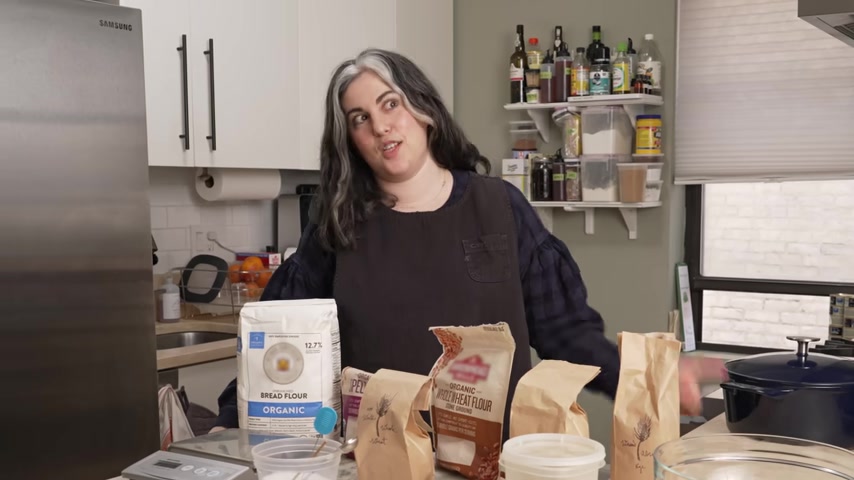
Shall we talk about how we're not at the cabin and it's not done yet and then cut to photos of the camp and being built , right ?
We can do that .
Just did it .
Ok , great .
Hey , everyone .
I'm Claire .
Welcome to my home kitchen .
I'm so happy to be back .
We took a little bit of a break so I could finish some major projects .
And now those are pretty much wrapped up and I'm so excited to be here for more episodes of dessert person .
And today we are starting with a sourdough bread recipe pretty much two years too late for that trend .
But for any of you out there still making sour dough .
It is one of my favorite pastimes and hobbies .
And I'm gonna show you my kind of like clean out the pantry sourdough bread .
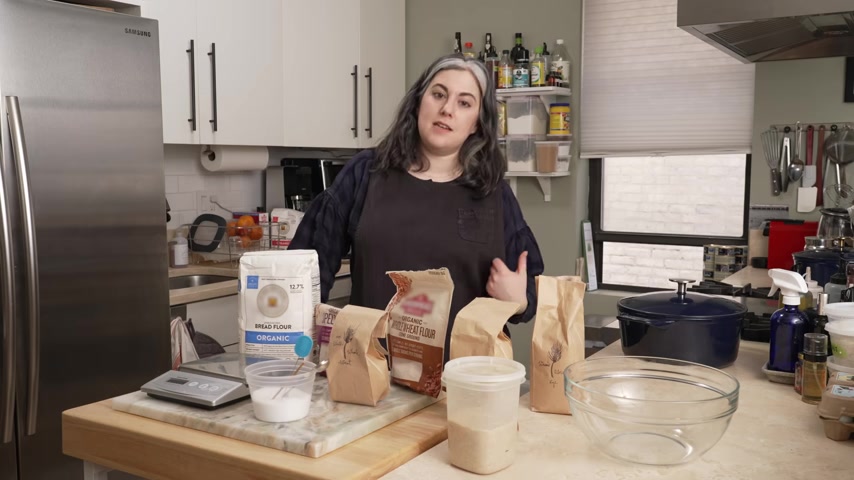
Why do people make sourdough bread ?
Why do people make bread ?
Ok .
Well , I think it's a personal journey for everyone who is into sourdough for a lot of people .
It's just about having delicious fresh baked bread , which I certainly understand for other people .
It can be almost like a practice , sort of like ritual thing that you do .
I love it .
I think it's a fascinating process .
Um And I do it because it's a great compliment to all the baking that I do .
And plus I love fresh bread .
Nothing better .
I think that one of the reasons that sourdough got really big early in the pandemic is that it's like time consuming in a good way .
You're sort of on the bread schedule .
Um , for anyone that isn't familiar sour dough , it is a type of what we call naturally leavened bread .
So , meaning that instead of using commercial yeast , like active dry yeast or instant yeast , we are using yeast and bacteria naturally colonized from the air around it .
It's , you know , all yeast and bacteria are everywhere .
And so we use something called starter .
The point of this bread is to like get rid of a whole bunch of loose flowers that I have randomly from all my recipe testing .
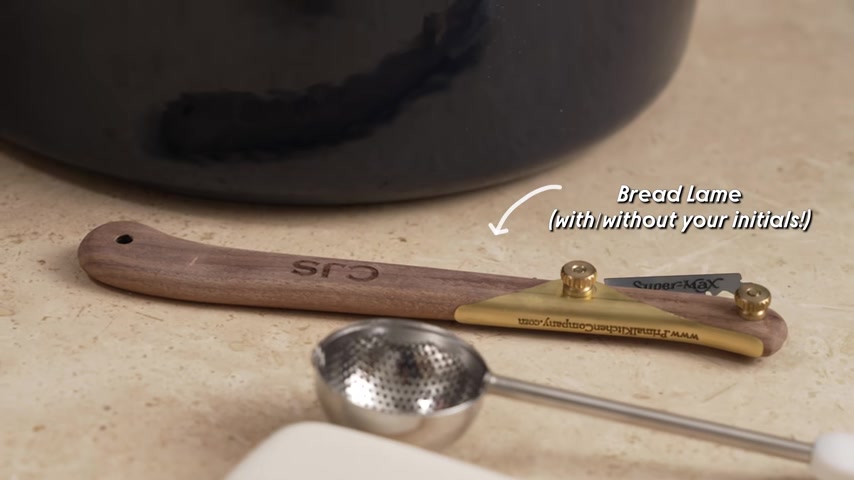
So it's practical and fun .
The most important thing .
Well , they're all important .
There's only four things flour .
If you wanna just use red flour , that's all you really need .
I have kosher salt , I have starter and tap water .
If you have filtered water , that's good .
Um the tap water will be fine .
You definitely need a kitchen scale for this because the proportions are very important .
You'll need a Dutch oven and then a couple of other little tools here and there like a bench scraper .
But overall , it's fairly minimal Hi , Maya .
Hi , Kitty .
Hi , Kitty .
Hi , Kitty Cat .
So , before we get into the entire bread making process , I want to thank in our sponsor for this episode and I'm excited to introduce this brand new product from their line .
It is a 5.5 quart Dutch oven .
Enameled cast iron is a super requested item and it took them years to develop and create .
It's made in France , beautiful oatmeal colored interior , navy exterior .
I love cooking and baking in Dutch ovens because it's so versatile .
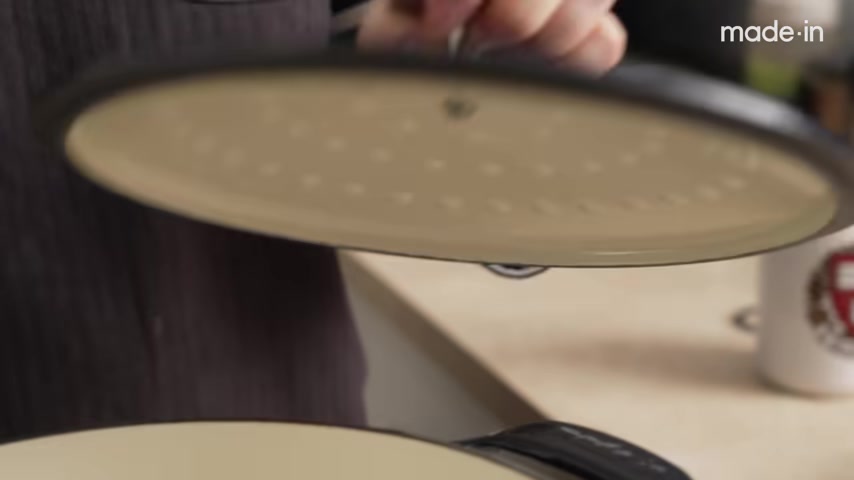
It retains heat , it disperses heat .
It's perfect for baking bread .
It has this metal handle which you do not need to take off .
If you are baking it at high temps and on the bottom of the lid , you'll notice these little beads .
This is so that when the lid is on condensation collects drips down kind of self basting just really lovely features in this Dutch oven .
So if you go to the bottom of the episode , there's a link .
If you use the code clear , 15 , you can get 15% off your entire order .
Not just the brand new Dutch oven .
I think it's one of the most versatile pieces of cooking equipment you can get .
So I highly recommend it .
And now we're going to get back to the episode and I'm gonna show you how to make your bread dough and why I love baking bread at home and you need a De Oman to do it .
So the first thing I want to do is weigh all my flowers .
So when we talk about flour and you know all the ingredients , you're adding it , we use what we call baker's percentages .
So flour , whatever your total quantity of flour is , that is 100% .
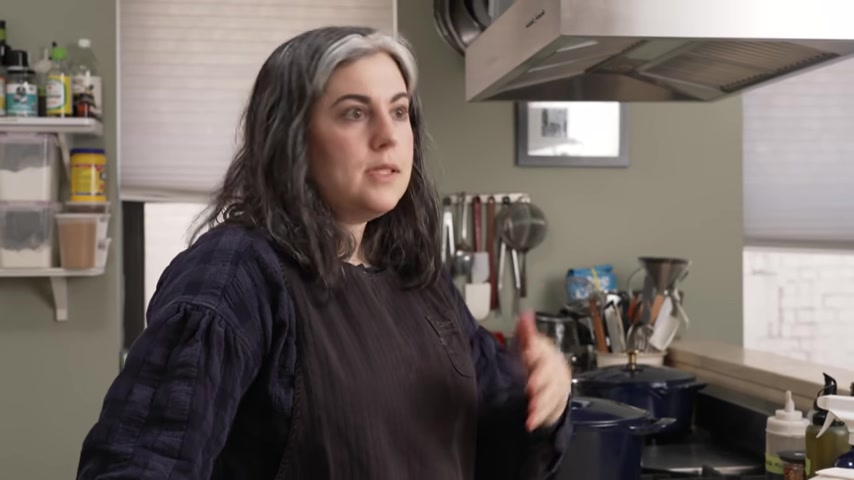
And then every other ingredient is measured kind of as a percentage of flour .
So people might say like , oh it's 80% hydration .
And that means that by weight , 80% of the total weight of flour is what you add in water .
So I like to use 1000 g or a kilo of flour total .
It makes percentages super easy .
And then when you add the water , you know what the proportion is because you know , if you add 750 g of water , 75% hydration and everything else is measured as a percentage of the flour as well .
So a standard percentage of salt is 2% .
So it just makes all the amounts really easy to follow up .
I'm gonna weigh all my flowers and mix in a little sorry .
So today I'm gonna do 500 g of bread flour and then 500 g of a mix of other flowers .
So I have 500 g of my white bread flour .
I'm using odds and ends here .
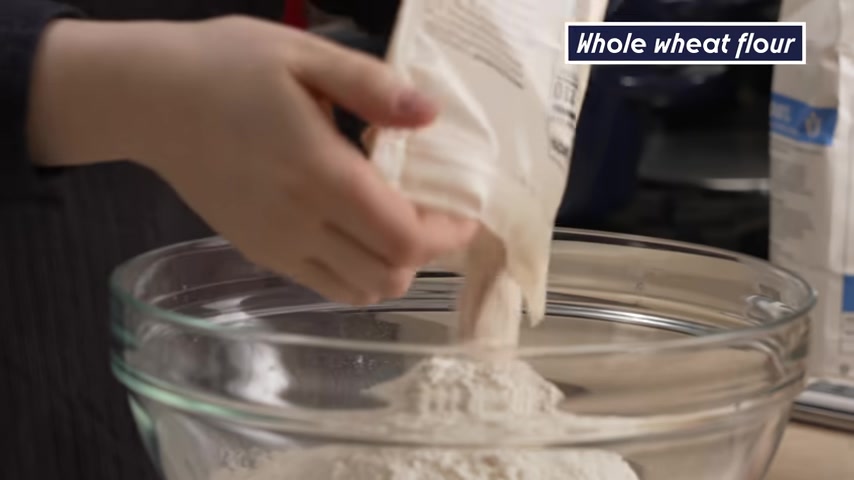
So this was like , I took out all of the random flowers that I have in my kitchen that are wheat , flowers spelt some , I'll add the rest of this whole wheat flour .
You could do 100% bread flour .
If you wanted , the more white flour , you add the kind of lighter and more open your bread will be .
However , it won't have as interesting a flavor .
So that's why I like to do a mix .
I wanna kind of balance texture with flavor .
So now I'm adding spelt spelt actually has a slightly lower protein content .
So when we think about flour and bread making , we think about protein content a lot because protein content correlates to the amount of gluten development gluten , which we've talked about many times are these like stretchy strands that develop when you mix wheat flour with water .
And this gluten network that develops is what traps like the gasses that the yeast produces and gives you , you know , the holes in your bread and lens it .
You want a decent amount of gluten development so that your bread is not just like super dense .
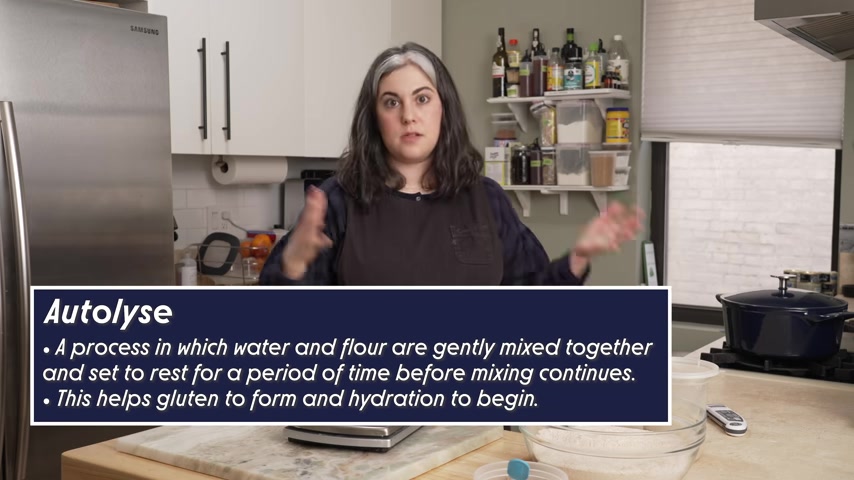
So spelt and rye don't actually have what's called functional gluten and they're not really true wheat flowers um but they develop great flavor .
The yeast and bacteria and starter love whole grain flowers like rye , all I need to do is get to 1000 .
So I'm just kind of adding here and there freshly ground whole wheat flour .
You can see the differences in the flowers like this is a whole wheat flour .
It's kind of yellowish , kind of golden .
This one is like a little more kind of grayish , almost a little bit blue .
I'm actually gonna add the rest of this .
Oh , but I'm almost 1000 is sort of an initial step in bread making where you mix the flowers and the water and you let it sit , that helps to develop a lot of gluten like right off the bat and can also decrease the amount of mixing you have to do during the final dough .
Oh You guys , it's actually a really good thing .
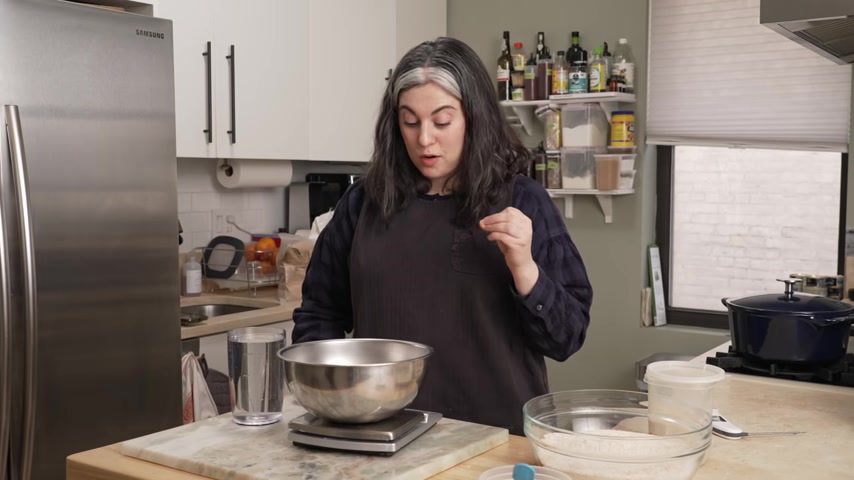
We haven't been shooting for the last couple of months because they were doing as best disa on the roof of the building next door , which I'm on floor the building next door is like stories .
So the people on top of the roof right outside , I mean , we could like have a conversation and it was so loud .
Jack hammering had this like crazy blowtorch thing .
So glad it's over here is 750 g of water .
So 75% .
I'm also gonna add more water later on when I add the salt .
So this is a bowl scraper because it's curved and flexible for scraping the bowl .
I'm not using any kind of electric mixer for this and it can get a little sticky .
So this is really handy to have , it helps you work a little more clean for this quantity of flour .
We'll get two nice size loaves out of this .
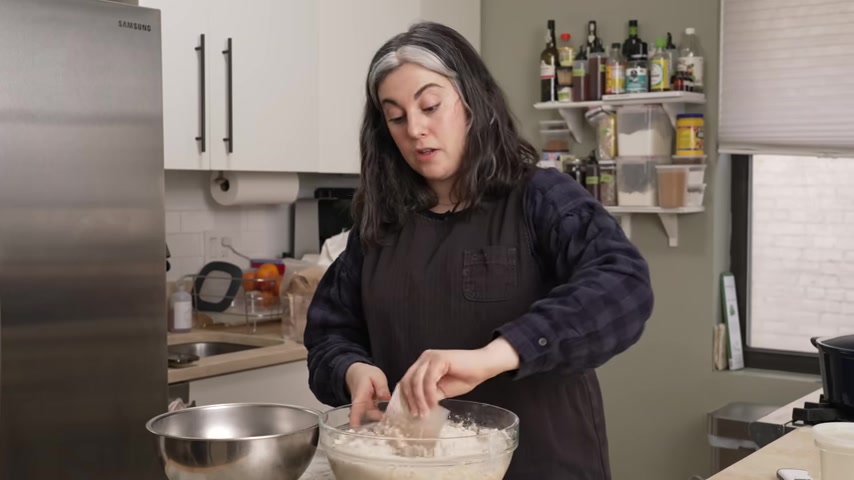
Now in goes my room temp water typically auto is done without starter .
So I'm going to leave it out and just mix in the water .
And at this stage , I wanna hydrate all the flour .
I don't want any dry areas , but I don't really need to mix it .
I just have to work the water through .
So I'm using the bench scraper .
So at this point , the water is worked in but it's not evenly mixed .
So I'm going to switch to my hands .
It's a little deceptive because it looks dry , but it really will loosen up .
So I'm gonna just kind of pinch it in with my hands just until you see no more flour spots and make sure you're kind of turning it and getting anything that's trapped in the bottom of the bowl because there will be some loose flour down there because I'm using kind of a different mix of flour .
Each time the dough takes different amounts of water just seems really dry .
So I'm gonna add another 50 g of water .
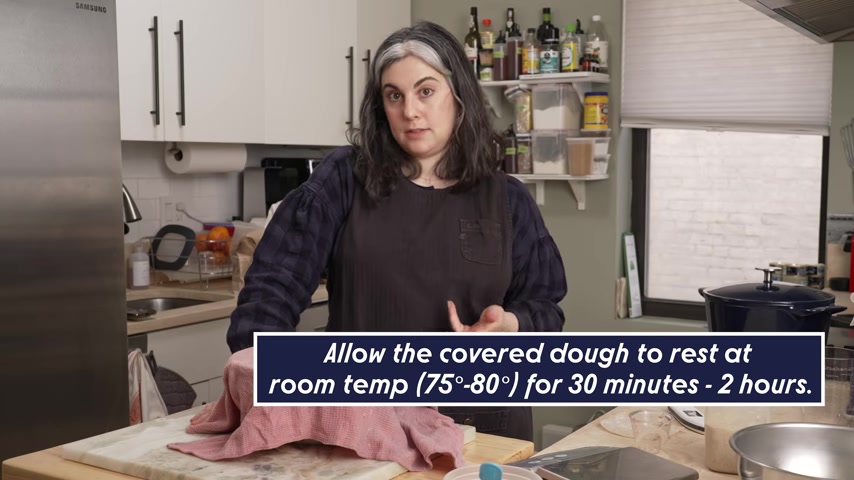
So that brings us up to 800 g total , 80% hydration .
So you just wanna mix until everything is hydrated .
No , no dry spots .
So at this point , this is how this should look just like super , almost kind of gnarly , not like bread dough .
I'm gonna cover this .
I'm gonna grab a kitchen towel .
So I'm gonna let this go for about half an hour .
And then we're gonna come back in and mix in the starter and the salt and then we move on to kind of , I think like the principal stage of sourdough bread making , which is called bulk fermentation .
So see this little line that I drew right there , that was where my starter .
That was its sort of baseline last night when I fed it , when I put it in this container .
And overnight , and this morning , the yeast and bacteria fed on the starches in the flour and produced gas and lactic acid and it grew and bubbled up .
And here's what I have now .
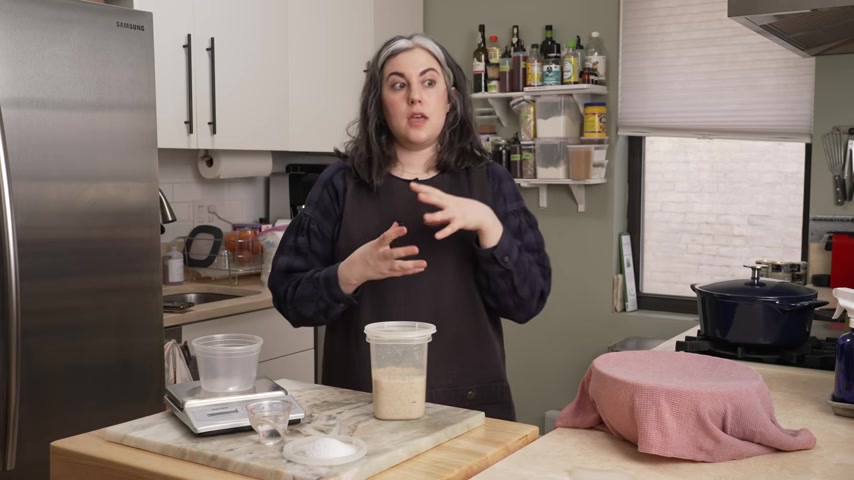
So it grew quite a bit how , you know , your starter is at its optimal point of use .
It will basically be at a point where it has grown and it will be super bubbly .
I , I sort of think about the bubbles as like , it almost looks like little sudsy bubbles like from soap .
It'll be slightly domed and when you jiggle it , it will look like it is about to collapse .
It will have so much air in it that it is really at the point where the bubbles are about to pop and deflate a little bit .
Now that has already happened here .
My starter is a little bit past its point .
There is like a high water mark right here and the starter has collapsed a little bit .
I wanna hurry up and use this .
So I'm gonna basically rush the , a little bit .
That is really where it would have been great to use probably like an hour or two ago .
What that is telling me is that , that those yeast and bacteria really need to be fed .
So I'm gonna do the flow test .
So I have some water here in this bowl .
I'm going to use the spoon to scoop out maybe like a teaspoon size portion of starter .
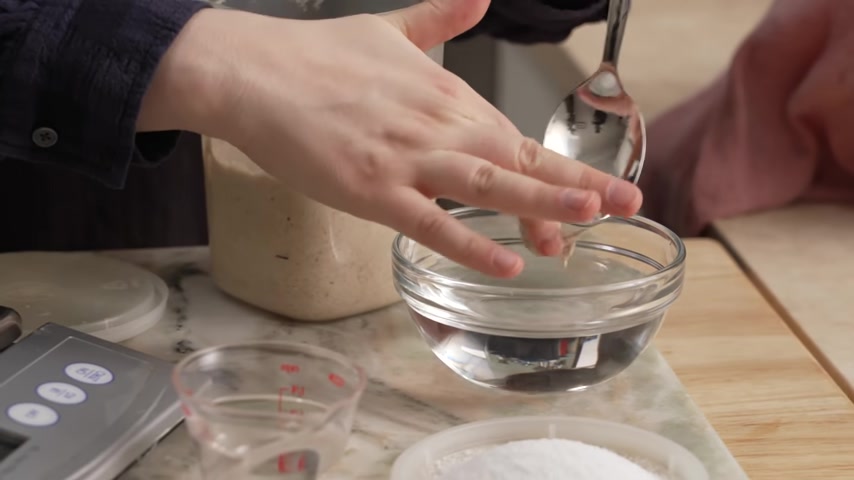
Now , the thing is , I know that this is over ripe .
So there's a chance it's actually not gonna pass the float test because it's deflated .
But let's see .
All right , it's floating .
If it floats , it means there is kind of an optimal amount of gas that has been developed in your starter and you're good to go .
If it sinks , most likely you need to go a little bit longer .
But if it sinks and you notice that you have this kind of like high water mark in your starter , that means you're past the point and it's basically , it was bubbling and then it deflated .
So you want to use it as soon as possible , you can still make good bread if your starter is like mine and it is a little bit past , but it's just not optimal .
You want to really use it at that right time .
There's ways to slow and speed up your starter and it's all about temperature if you're like , ok , like , you know , I want to go for a for a couple hours .
But my starter is looking kind of ripe , put it in a cool spot that will slow things down a little bit .
The opposite is true .
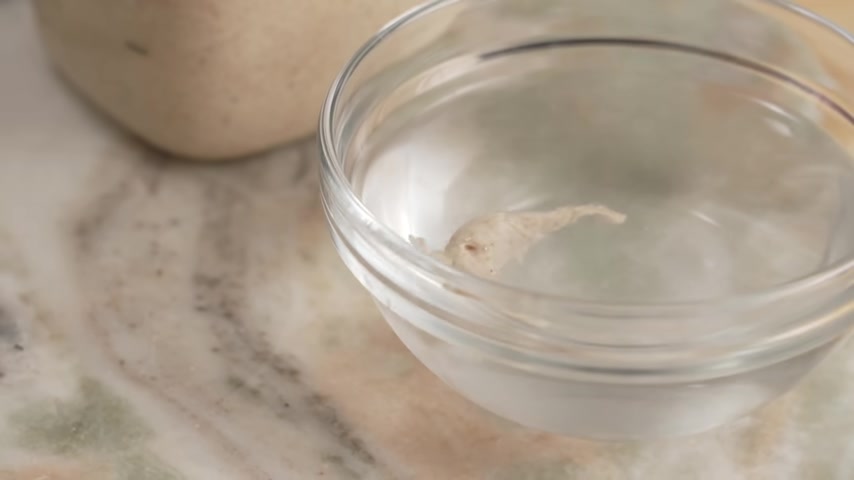
If you're like , oh , I got to get this bread going , put it in a warm spot and it will start to activate .
We're gonna weigh out our starter 200 g .
Now , I'm not weighing it directly into the bowl , although that would be easier .
But that's because with weights this high , it's not super accurate .
So I'm gonna weigh it into a separate container .
This is a starter that I fed mostly with white bread flour , but with a little bit of rye as well gonna uncover .
So I'm gonna start by scraping in my starter .
Now , when we talk about hydration , it does not take into account the hydration of the starter that's considered separate .
Here .
We have a very wet thing that I'm trying to mix into another kind of wet thing .
So it gets a little messy .
I like to use a pinching method .
So I use just thumb and forefinger and I pinch the starter in .

So you can see a little bit like the texture of what the flour and water mixture looks like .
It's definitely become stretchier , more elastic .
I am now going to add my salt salt does a lot of things to the bread .
It of course , seasons it like if you were to make bread with no salt it would taste terrible .
Not good .
It just , it seasons it , it makes the bread taste like bread .
But it's also going to tighten up all of the gluten and to incorporate the salt really thoroughly .
I add additional water when I add the salt .
So I have , this is 20 g of kosher salt .
I weighed it out .
That's 2% .
You could use a fine sea salt .
I just wouldn't use table salt .
It looks like a lot .
But I really , really recommend you use the full 2% 50 g of water .
So this will bring the hydration up to 85 .
So I'm still using that pinching method .
It's a little squishy .
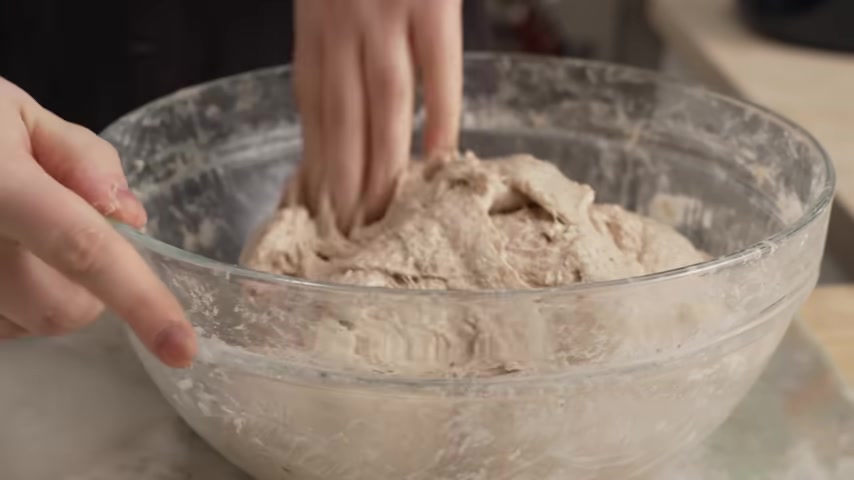
Oh , sorry .
Not a great noise .
Remember those shows on Nick where they be like slime people ?
I would be so mad if I guess you don't do that show unless you are prepared for that .
But like I'd be like , oh my God .
All right .
We'll cancel the ruined a good hair day .
The dough has mostly absorbed the water .
It's a little wet .
It still feels pretty tight like it's firm .
So now that I've incorporated the starter and the salt , the next step is to work the dough a little bit .
I think it's easier , especially for beginners to just keep it in the bowl and to just do this kind of lifting and turning motion .
So it is basically a kind of scooping down of the hand along the side of the bowl , grasping onto it , lifting it up .
I like to give it a little shake to kind of stretch it a little and then pressing it down toward the center .
It's kind of folding it onto itself .

I'm going to continue with this motion until I see a couple of things .
One is just increased smoothness .
So a more uniform texture , I will have less stickiness .
So there will be more absorption of the water .
I will also see increased elasticity , which is the desire of the dough to kind of spring back into its shape as well as extensibility .
So the ability to extend .
So when I grab the dough and I pull it up , it breaks apart pretty easily .
So that is a sign that like it's not very well developed .
And I like to make two loaves at a time .
One because the math is really easy and two because people love getting it like I can give it away and I also freeze it right .
Can we do that one more time ?
Having a good time .
Slow lift , love bread .
OK .
Turn that high , I'll break off .
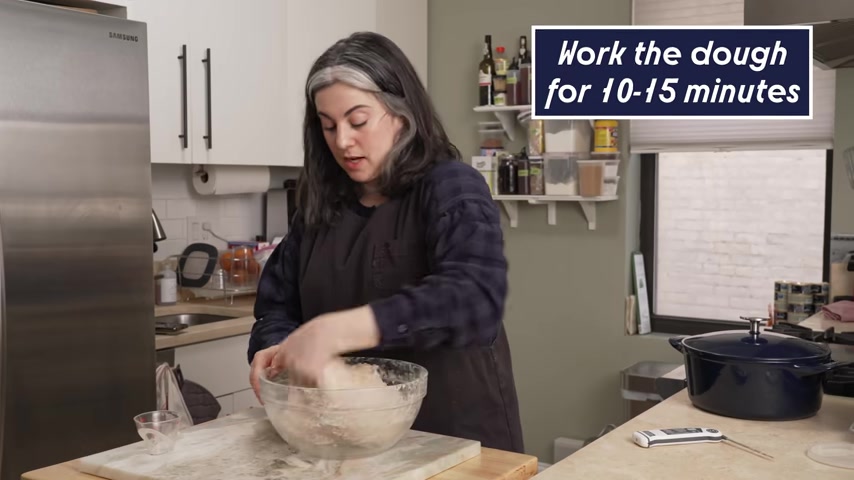
I think you could probably do this for , you know , 15 or so , maybe 10 .
Depends , depends on your flowers .
Depends on how long you did .
Your auto leaves .
75 .
All right , we're still 74 75 .
So we're a little bit below the desired dough temperature .
So I'm gonna try to mix it pretty vigorously so I can bring up the temp .
One thing I like about bread baking is it feels kind of like primal .
And there haven't been like , there's been sort of an increase in understanding of bread making , but fundamentally , it hasn't changed that much over the centuries .
And so I like doing it by hand .
I feel like it's kind of meant to be done by hand .
Could I mix this dough a little bit more ?
Yes .
Do I want to not really .
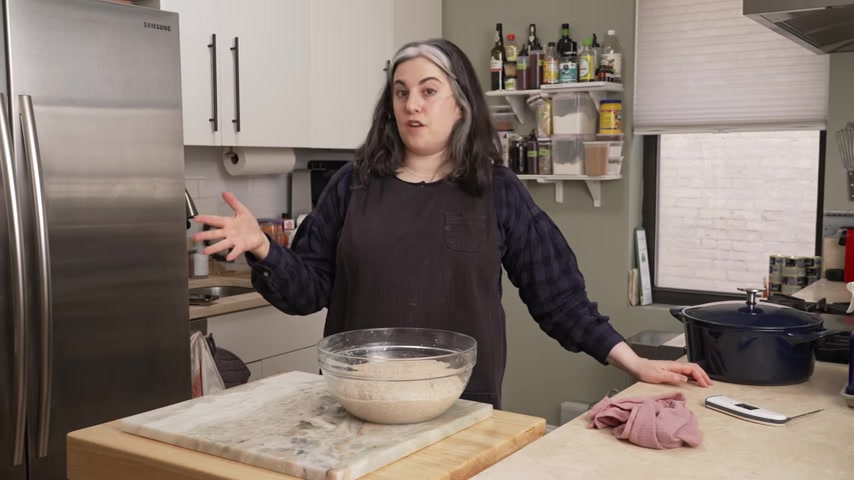
We're going to move into the stage of bread making called bulk fermentation bulk only because we are doing the full amount of dough all at once fermentation because this is the stage where the yeast that was in our starter is now feeding on all of its new food sources and is going to produce gas .
We want to maintain the strength in the dough that we developed some of that gluten kind of relaxes and can start to break down if you let it .
So to counteract that forest , we're going to do a series of folds as it goes through bulk fermentation .
But it's looking kind of modeled , it's looking pretty dense , like there isn't a lot of air in it when I do this , I'm not seeing a lot of like jiggling .
So we're going to see some pretty noticeable changes as it goes through bulk fermentation .
But for now we gonna cover it .
We're at our , you know , in the range of desired dough temperature .
So I'm just gonna let it sit at room temp and we'll come back and check on it in an hour .
I'm gonna uncover it .
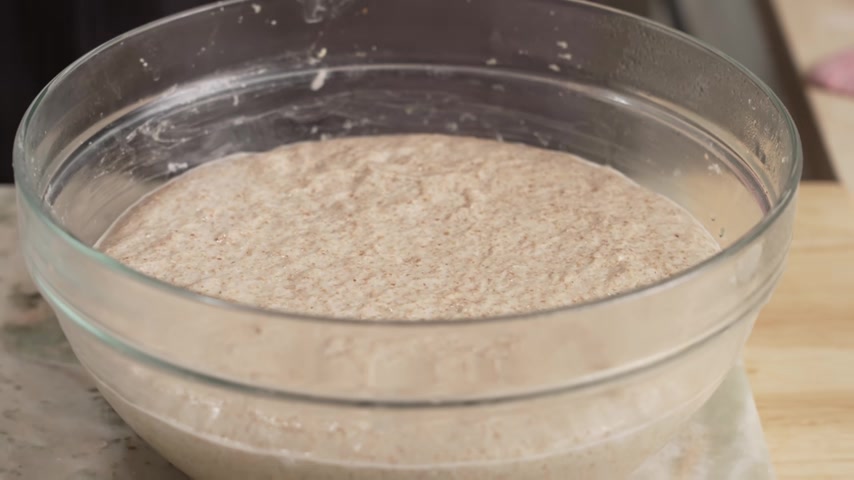
The first thing I notice the surface has settled a bit .
So it is a more the dough is relaxed and I have more of sort of a flat surface to the dough .
So here's how you do the folds dampen your hands .
And then I'm using a similar motion that I use for the mixing .
But I'm going to go into the two hands kind of on opposite sides of the bowl and I'm gonna lift and kind of fold the dough onto itself .
So I'll show you .
So I'm kind of gently stretching it upwards to see how it's pulling away and then I can fold it onto itself , had a little bit of sticking , but generally wet hands is really effective at preventing sticking .
Then I gave the bowl a 90% turn .
I'm going to go in and do the same thing .
And I'm being gentle , I don't want to deflate a lot of the gasses that I'm building up currently .
But at the same time , you can handle it a little bit .
So kind of just doing one more for good measure .
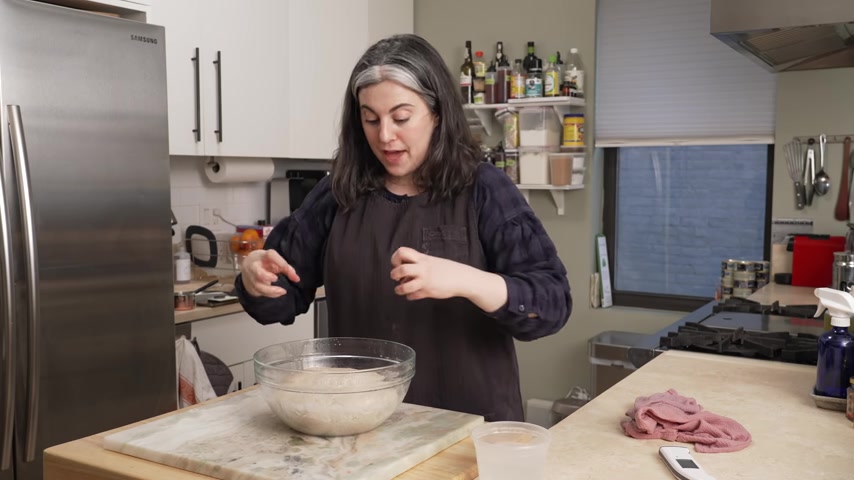
The reason we're doing these folds is to continue to build and also maintain strength in the dough .
So that folding action is helping those gluten strands kind of link up and form these long chains and creating this internal network and that's what we want .
That's going to trap the gas that the yeast is currently generating as it ferments .
That was all you do .
So , again , in an hour , we'll do that folds back off to the side .
I'm gonna try to put it in a warm spot because the dough is cooled down a little bit .
Um And then we'll just come back in an hour .
So an hour later , we're gonna look at our dough .
What I'm seeing here as I'm seeing some light bubbling across the surface , it has settled a little bit , but it has also sort of started to expand in the bowl .
I'm seeing bubbles around the sides .
Wow , it's dropping .
All right .
So I gotta warm this guy up .
So I have some warm water here .
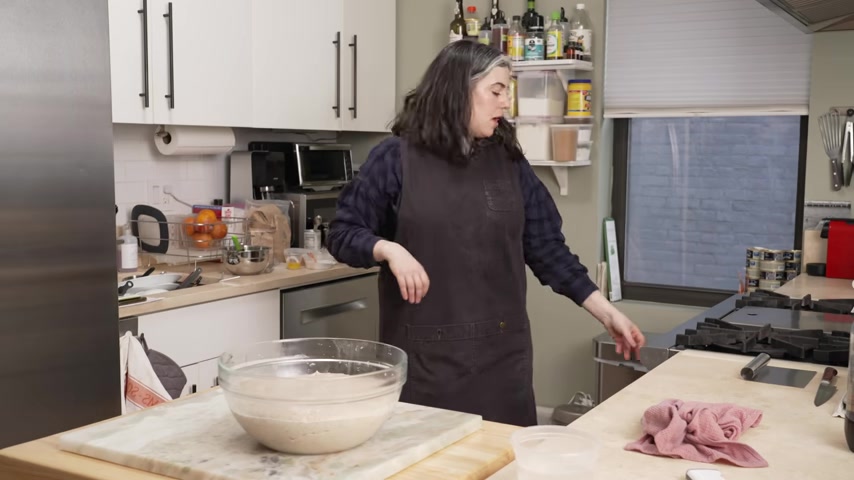
I'm gonna turn my oven on pretty low and I'll have it sit right near the oven .
So the same thing with some wet hands using warm water , I'm gonna come down and underneath the dough on two opposite sides .
I like to give it a little wiggle and fold it back on itself .
You can actually stay here rather than giving the dough or you can stay here rather than giving the bowl a turn .
The point of this is to strengthen the dough , build up those chains of gluten and make sure that we are maintaining that strength .
OK .
So now when I give the ball a little shake .
There's a little bit more of a wobble to it .
So that's a sign that we are building up that gas and this is going to go back under the towel and put it next to the oven so I can warm up a little bit .
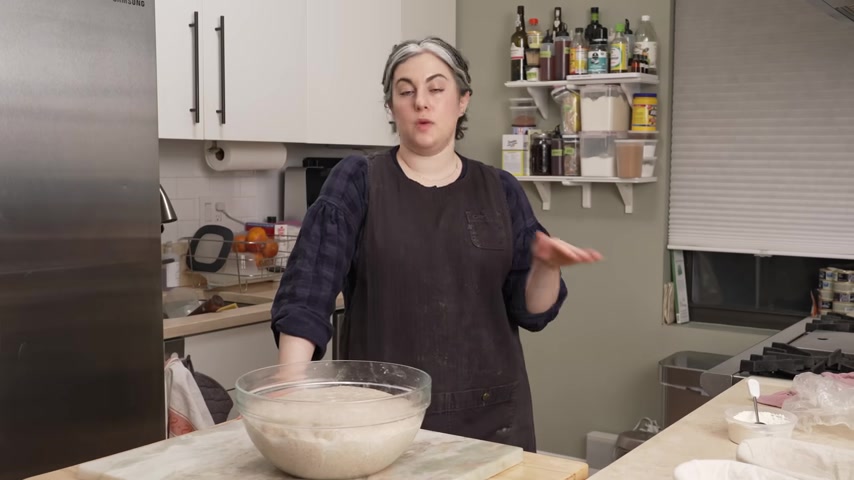
I just heard the oven kick on and then same thing in another hour and then we move on to what's called pre shaping , shaping and then proofing .
So I did an additional fold .
We didn't show it on camera .
I did about an hour ago .
So that was fold number three .
So when I give it a little wiggle , but it has a nice wobble .
So I can , I see little bubbles on the surface .
So here I have my bread baskets .
These are called Banat .
If you don't want to do this , you could do this in a colander , you could do it in a bowl lined with a clean kitchen towel .
That's all fine .
This here is a 50 50 mix of white rice , flour and regular , all purpose flour , rice .
So doesn't hydrate like regular flour .
And so it just prevents sticking to the cloth .
So I'm just giving a very generous dusting of this mixture into the baskets .
So I want to flour my work surface to prevent sticking .

I really wanna let the dough kind of pull itself out of the bowl .
There's a decent amount of water in here .
And so it really should kind of slip out .
Although I'm gonna tip out any water that might dribble onto the surface .
Ok .
So the dough is gonna kind of pull itself out and onto the floured surface .
Kind of go gently .
You don't want to pop too many air bubbles if you need to , you can use a little bowl scraper .
But all that water was really helpful .
It did help prevent sticking .
So I'm gonna quickly use my bench scraper to divide this in half .
So now I'm not gonna weigh , I just want to sort of roughly divide this in half .
I don't really care that much if the loaves are slightly different sizes , just eyeball it .
And this part I think is a little challenging because the dough is , does want to kind of stick when you start to divide it .
So I like to quickly kind of get my scraper in there pressed down and then give it a twist to kind of separate the dough .
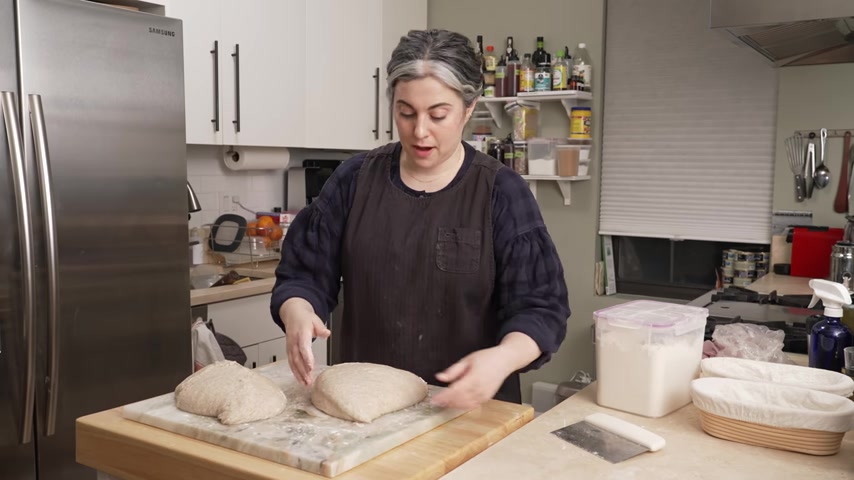
Wow , these are wildly different sizes .
There we go .
So move one over , you know , you don't want them to touch as soon as they touch , they kind of want to fuse back together .
And prep is a step that I do to help start to organize that network of gluten into the shape of the loaf .
So here I have the bottom floured and the sticky surface on top .
And I'm gonna kind of quickly gather all of the edges of the dough into the center like so into a little , a little bundle like this and then I'm gonna flip it over .
So it's kind of smooth side up .
I'm working quickly because the longer it touches your hands , the more it's gonna stick .
And then you're gonna use the bench scraper to work around the dough and basically tuck the edges underneath .
Now , it's important not to have a ton of flour underneath .
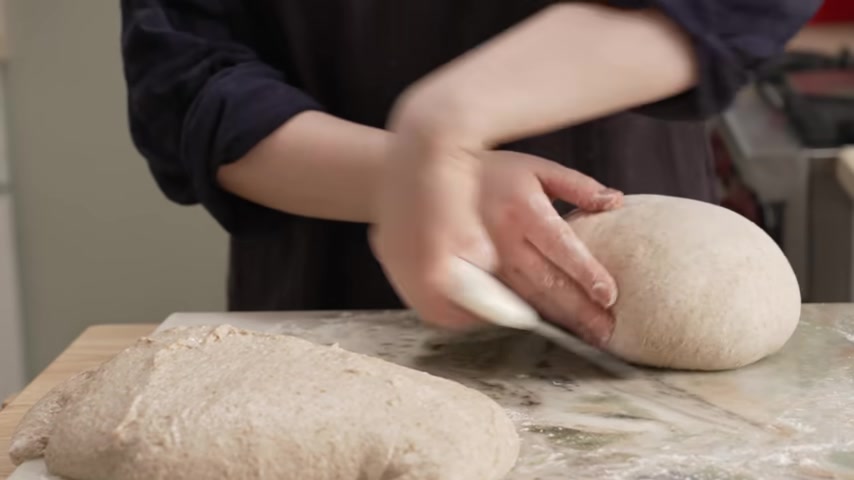
Otherwise the dough won't really have enough friction to like hold itself underneath .
But you can see as I work it and turn it and rotate .
It gets nice and tight .
I have this little sort of tight ball and that is my pre shaped bread .
This is just gonna rest here .
So we call this a bench rest and that is the step between pre shaping and shaping .
So I'm gonna do the other piece .
So same thing I have all these kind of like rough edges .
I'm gonna just lift all of them up , bring them toward the center and the dough is really gonna want to stick to itself , any flowered , any unf flowered surface , the dough will want to stick to including itself and then turn it over a little bit of flour .

Ok .
This one can go right here .
Now , I'm going to cover these with a clean towel , not the wet one because I don't really want to introduce more moisture at this point .
So I'm going to get a clean towel out these will bench rest for like 15 minutes or so .
I want the gluten to relax a little bit and then we're going to shape again and not only am I trying to reorganize the gluten into the shape of the loaf , but the final shape is designed to increase tension and give you a final loaf that rises like really tall and evenly in the oven and just gives you the nicest shape .
So this part I like to do quickly .
It's just kind of like all in one motion .
So at this stage , I'm gonna kind of flatten out the dough a little bit .
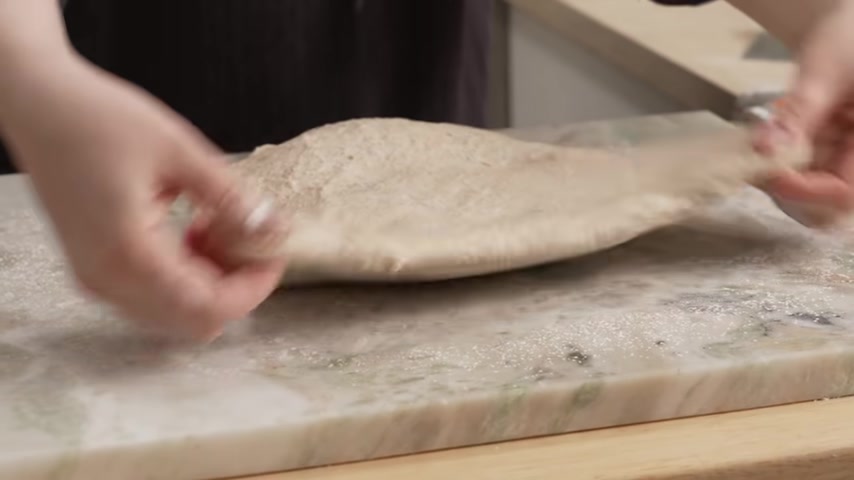
And the way that I like to shape is basically I fold in the sides , think about like making a burrito fold in the sides and then I roll it up from the end closest to me to furthest away .
So I should say that I'm going for a shape that's going to fit inside this ban of to it's called Batard is the shape .
So I'm gonna fold in the sides .
Now , this underside of the dough , the dough is going to easily stick to itself .
So that makes it easier .
OK ?
And you can give it like a little pinch .
Now , the idea here is to increase the tension of the dough and really stretch the dough over itself so that when you know the world is going to rest , but when it goes into the oven , it has this structure of gluten and tension so that it rises up nice and tall .
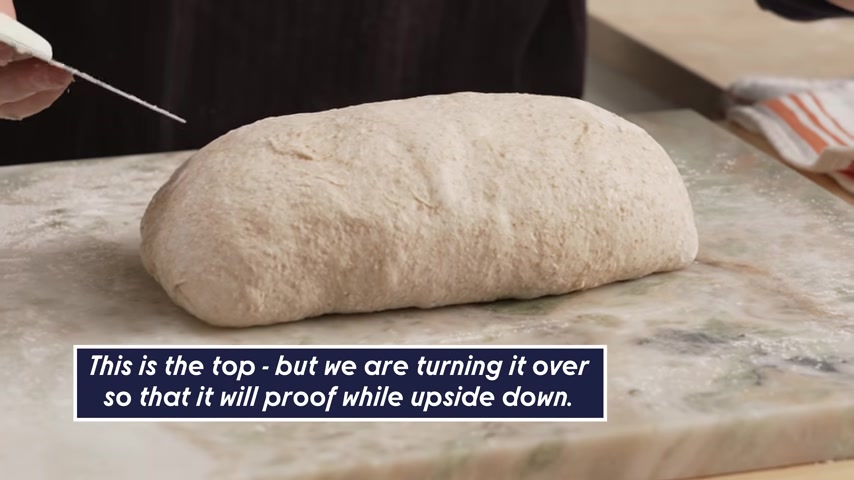
So I'm gonna start from this end just kind of roll it up like so , and as I roll , I'm kind of pulling back on it to increase that tension and then you can kind of give the ends like a little karate chop chop .
And now I kind of have to do that same motion where this is now going to be the top of the loaf and it's gonna go round it side down into the basket .
So I'll stand over here .
So you can kind of see what that looks like if you need to , you can give a little bit of flour on top just to prevent it from sticking to your hands .
You don't really want to use too much flour because you will end up drying out the surface of the dough more than you want to .
So bench scraper go like that .
Whoop .
See you .
There we go .
So it's like a little , it's like a little baby , tiny bit of flour on the surface .
So you can pinch any seams that you want to close .
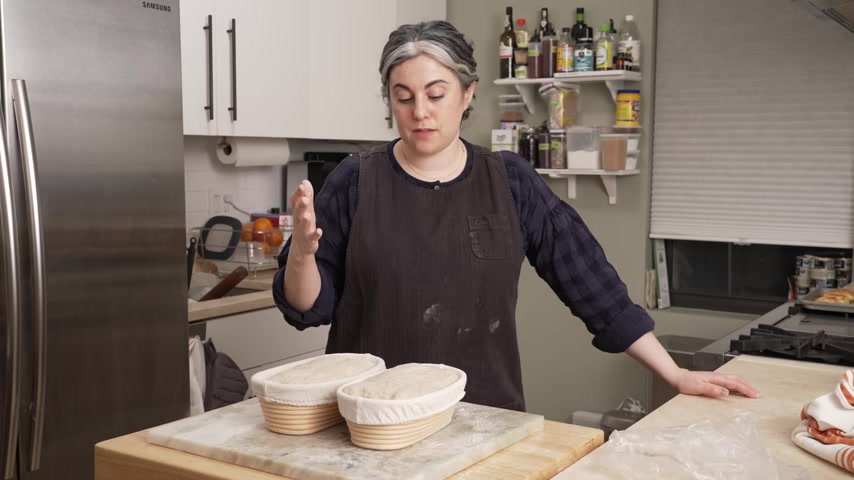
And now I'm gonna shape the other one just like this and to prevent the dough from drying out too much , I'm gonna cover it .
This is , I mean , I think it's literally a shower cap .
It's just a plastic cover with some elastic around the edge .
It creates this like nice closed environment for the bread we've already developed , you know , a nice amount of gas and air in the lobes and proving is a chance for the dough to relax a little bit for the lactic acid to continue its development of flavor .
This is really about developing flavor .
The bulk rotation is about developing , you know , all the air and the gas that you need in the loaves .
Um And this stage moving into proofing is about flavor development .
So I wanna let the loaves relax .
Proofing to me is like some , one of the more kind of like inexact steps or parts of the process .
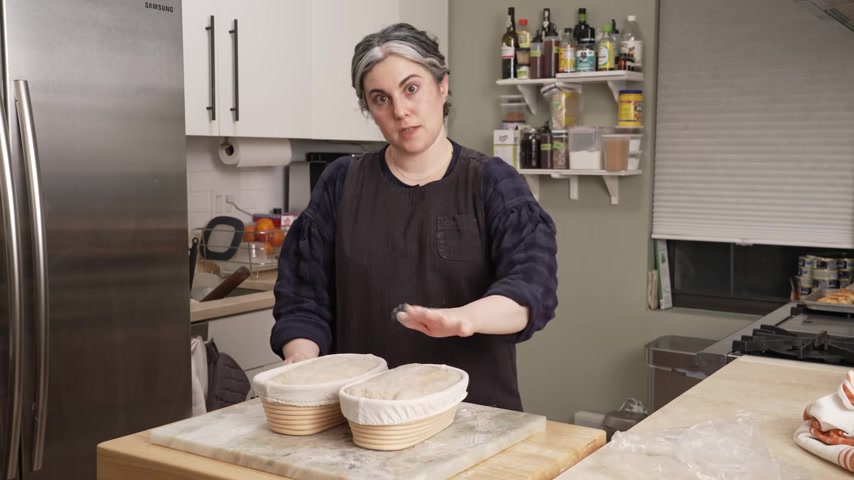
But what I'm looking for when the loaves are proofed , they will have settled into their baskets .
You can see they're a little bit domed , they're riding a little bit high , they'll settle in .
I'll also see a slight expansion in size and I'll just make all the poke test , the dough will spring back , but actually leave a slight indentation , which is a sign that the gluten has relaxed when I poke the dough .
Now it springs back immediately .
So these have a ways to go before they're approved .
So unfortunately , you're not gonna be here for that step and by you , I mean , my crew because I cannot keep them here all night .
So I'll take a little video show you what that looks like when they're proofed and then they're gonna go into the fridge .
It could go for , I'd say maybe like between one and two hours for proofing .
We'll see , see you , see you tomorrow .
The crew left about an hour ago .
The dough is proof .
I'm gonna show you what it looks like .
You can see .
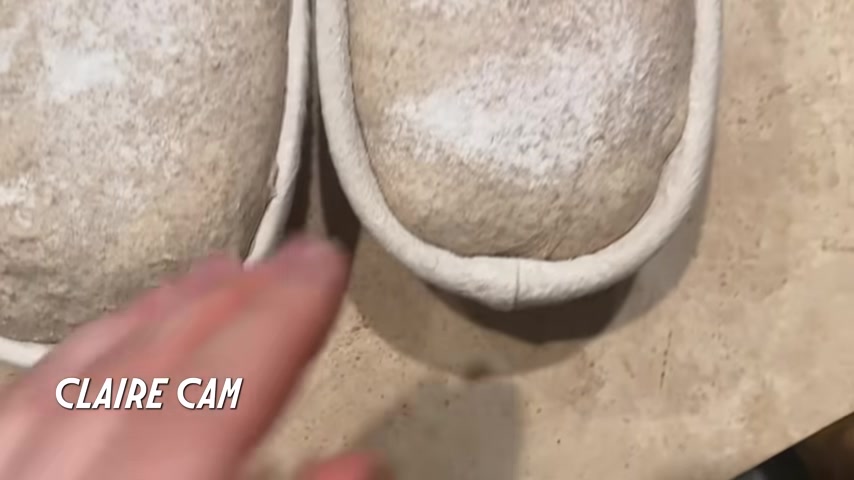
The larger of the two has risen almost out of the basket .
The second one has totally filled it in the surface has settled .
So it's nice and flat .
I'm gonna show you the poke test .
I also gave it a little more flour because I didn't want it to stick to the cover .
So I'm gonna show you the Pope test .
So see how when I poked it , it slowly sprung back and then held the annotation .
That is a sign .
I'll do it again over here .
So see how it's slowly springing back and holding the invitation .
So that is a sign that these guys are approved .
So I'm gonna cover them again and put them in the fridge and we will bake tomorrow .
I woke up this morning with a little pep in my step because I get so excited every time it's baking day .
I'm not exaggerating .
Like I literally wake up and I'm like , I get to bake bread .
I'm so excited to see how it turns out .
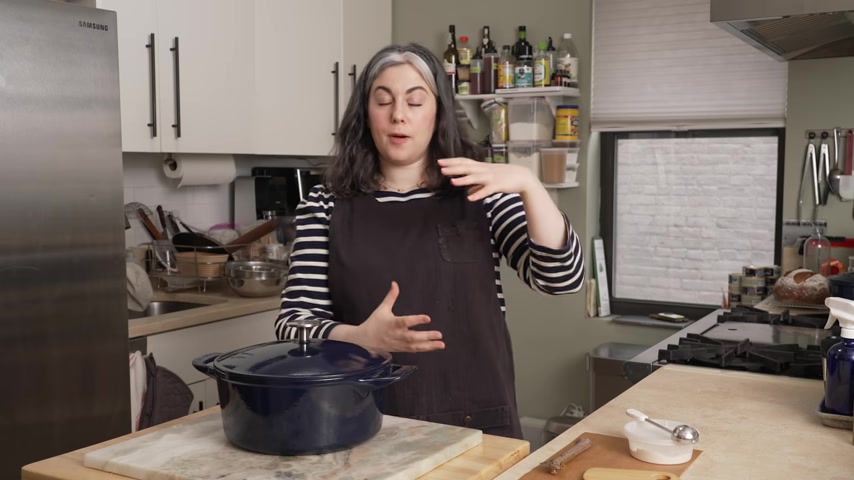
It's always like a little different and kind of mysterious and fun and it's a discovery every time I bake bread .
So today is the day I have my Dutch oven here .
So Dutch oven bread baking is a really common method .
I think it's the easiest and most effective home method for baking bread .
And the point is that you're baking in this closed vessel for part of the time , uh with a very tight fitting lid because you want to build up steam as the dough begins to bake .
So the point of that is to keep those starches in the bread pliable .
So that in the early part of baking , when it's really , really hot , you're going to achieve maximum oven spring .
So what happens is all that gas that's trapped in the dough is going to heat up and expand and raise the dough and create all those holes in your bread .
And you want to keep some steam in there so that you can achieve this maximum sort of volume increase called oven spring .
Then you take the lid off and you let the dry heat of the oven really create this beautiful golden brown crust I have .
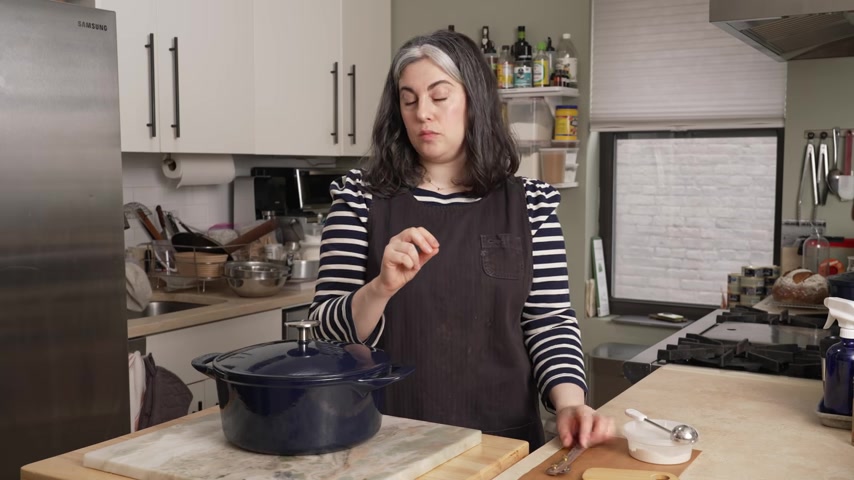
This is like a kind of a fancy what's called a lamb .
Lamb just means blade in French .
But it is the term for basically a razor blade on a stick .
This is for slashing the bread .
Um You could just use a razor blade if you don't have that , you could use ideally a sharp serrated knife .
OK ?
And then I have just that 50 50 mix of white flour and white rice flour for dusting a piece of parchment paper , you know the dusting wand and this is just a little brush for removing flour from the bench .
Not , not required .
A very important step in bread baking is really preheating your oven thoroughly .
So bread ideally bakes it a super high temp .
Most ovens max at around 500 degrees .
So that's what we're gonna preheat the oven to in my made in Dutch oven .
It is oven save up to 500 which is great .
I like to actually just preheat the bottom of the Dutch oven rather than the whole thing .
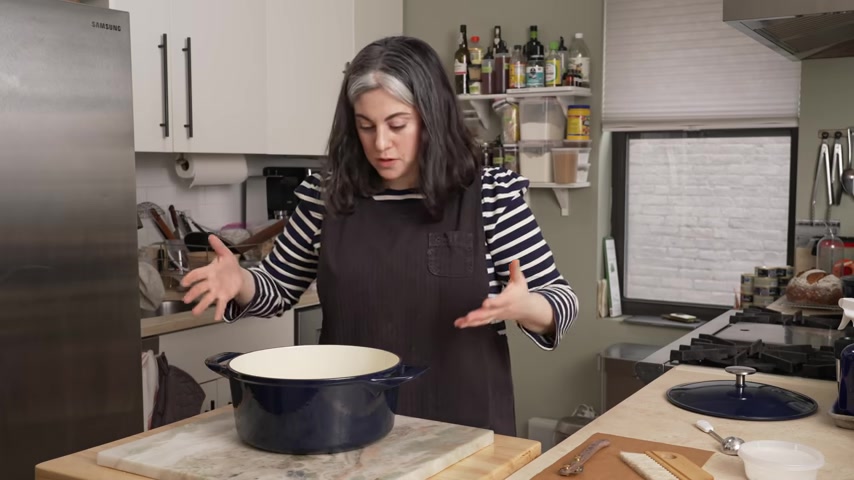
It's just to me feels like a little bit safer because you're handling this big piece of equipment that is literally 500 degrees and it is super hot .
So I'm gonna , I have my oven rack in the bottom of the oven because you need some headspace .
You wanna preheat it for a long time .
You wanna really , really make sure that the Dutch oven is like fully retaining this super high heat .
So I think it could take in my oven .
It takes like 45 minutes or so .
I would allow yourself at least that for the preheating stage .
So this is gonna go in and make sure that you have like reliable and safe oven mitts or some kind of glove or just really thick towels because you are gonna be handling this very hot piece of equipment .
So I use oven mitts , sometimes not oven , not all oven mitts are created equal and I have definitely burned myself through an oven mitt .
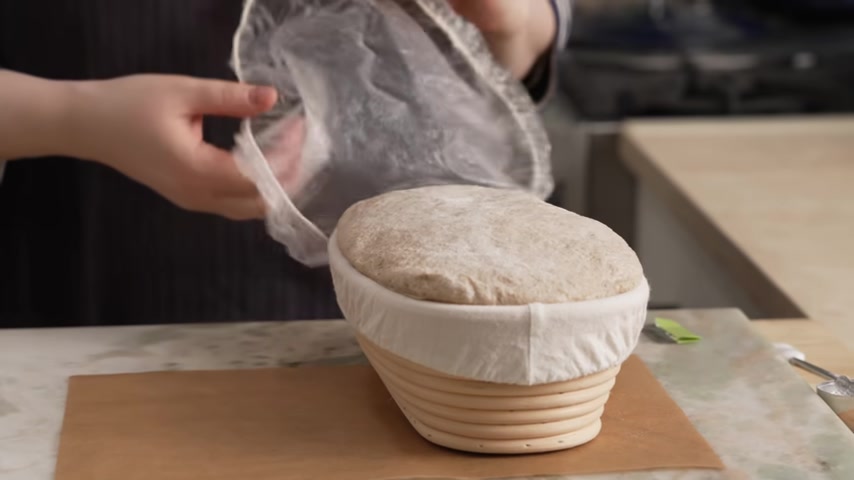
So just make sure you're using something that's really , really heatproof .
This brush is not required .
I just think it's cute .
So I have it here for like dusting stuff .
Why do we slash the bread ?
Great question .
The reason we slash it is so that we give the dough a predictable place where it can start to expand .
So you don't have to .
There's certain styles of rye bread where there's , it's like a , a lower amount of oven spring that are just allowed to kind of naturally crack and they're beautiful and I love the way they look , but with this kind of bread , we're gonna slash it .
So as you saw from my vlog , I let it proof last night for a couple of hours and then stuck it in the fridge and here she is .
So I'm gonna take off a little plastic shower cap .
So there was a little bit of condensation that gathered in the bag and then on the surface of the bread .
So I'm gonna dust the bottom with a little bit of flour , not a lot .
It could have a tendency to burn .
So I don't want to add too much , but just enough to prevent sticking .
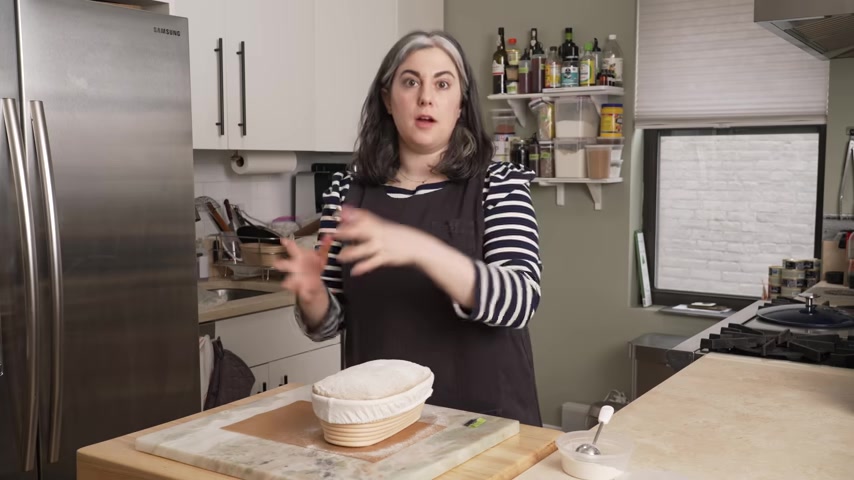
And I do bake this um on a layer of parchment paper , which is a means of lowering the bread into my 500 degree Dutch oven .
So there's an extra little layer there .
So here's how I do it I have a piece of parchment paper .
It's not a very large piece .
I just need something that's about where the width , the parch of paper is about the length of the loaf .
And I have a couple of inches of overhang on either side .
So I like to very gently turn the bread out .
I think I sometimes handle the bread more gently than it needs to be like it's pretty resilient , plus it's cold .
So sitting overnight in the fridge that helps to really firm up the dough and makes the stage easier .
So I do , I almost 100% of the time bake my bread from cold .
You can be , you don't have to be quite this gentle .
And then I'm gonna slowly lift off the basket and the liner .
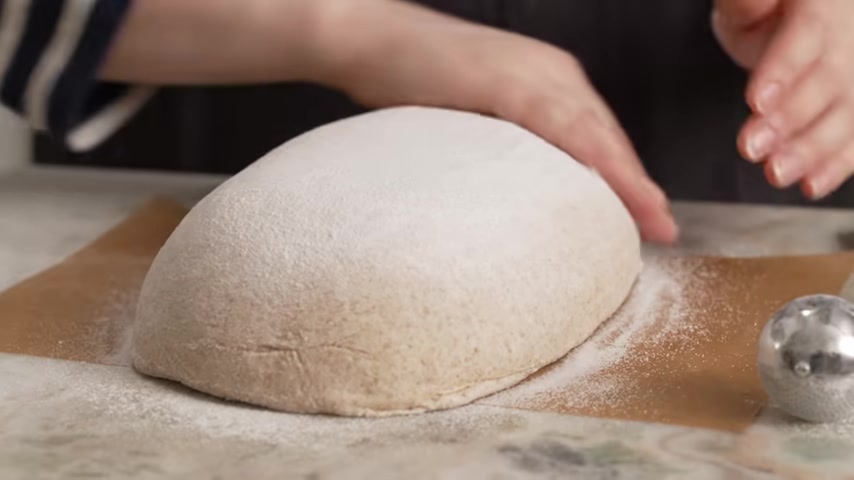
So one of the great things about rice flour , I believe this is a uh Chad Robertson technique is that white rice flour , it doesn't take on color the way that the wheat flour does .
So it retains this kind of snowy white color .
And then you get great contrast between the exterior of the dough and where you made the slash for this shape .
I like to do two slashes .
I just kind of like the effect that it gives and I curve the blade a little bit because it's flexible .
And I also hold it at what I would say is maybe like a 30 degree angle , 45 to 30 .
And that is what is going to create this kind of ear .
But you just want to kind of go quickly and confidently that's all you need to do .
I'm gonna grab my hot dutch oven and bring it out to the stovetop , good gloves and I'm gonna work quickly because I don't want this heat to really dissipate sides of the parching paper to lift the loaf and place it inside .
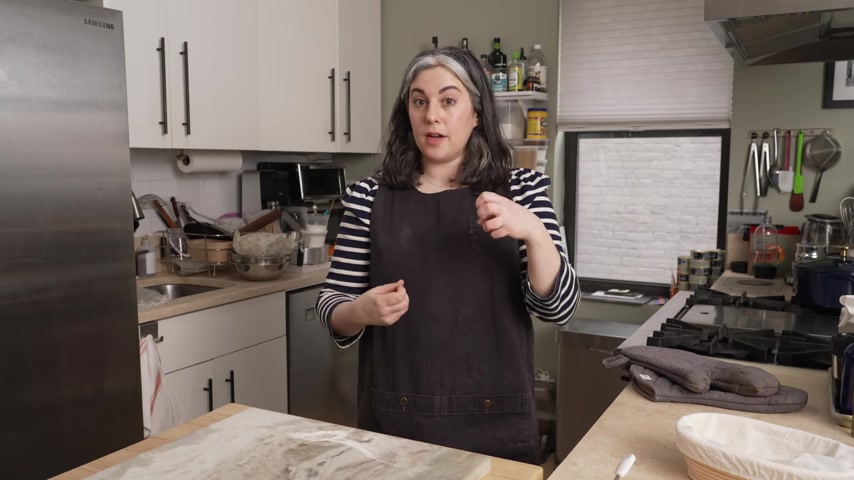
So the lid goes on and everything back into the oven working pretty quickly .
Oh , that is hot .
Ok .
That to me is the most nerve wracking part .
I mean , at this point , I've done it enough times that it's comfortable .
But I would say the first 25 times I did that , it felt like a little dicey .
Don't worry .
I think it's more forgiving than you even think that is going to bake with the lid on for 15 to 20 minutes .
Sometimes I split the difference and call it 17 or so .
But that is the amount of time that the loaf requires to achieve its maximum oven spring .
It happens early on in the baking process .
And once that's done , we remove the lid and that allows that trapped steam .
So there's like all this moisture inside the dough , it generates steam with the lid on .
That helps the dough to achieve its maximum oven spring before the crust starts to set .
Then we take that off .
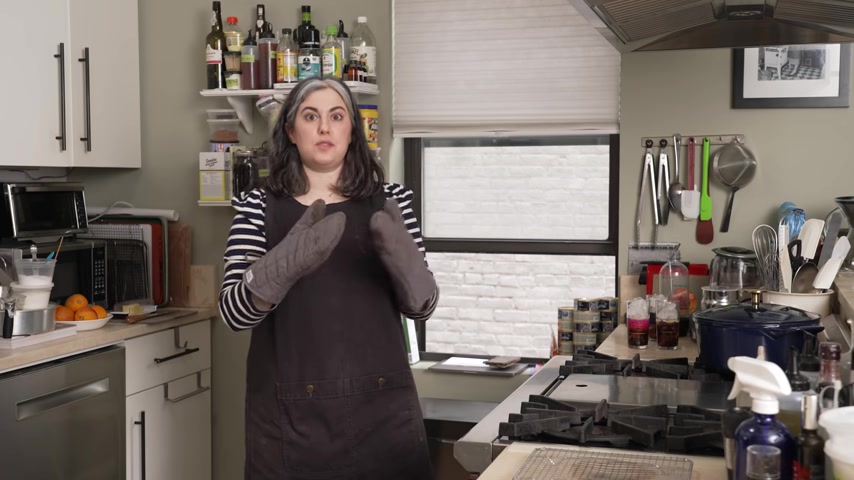
The steam kind of disappears and that dry heat from the oven is going to create a really well developed crackly like deep brown crust and that's what we want .
It's been 17 minutes or so , I'm ready to pull the lid off .
So now we want to release the steam .
Now that we have our oven spring , our loaf is going to look really tall , but it's going to be very pale .
So it doesn't take on color until the lid is off .
Then we let it go for another half an hour or so and develop the crust .
So I don't need to take it out .
I just want to grab the lid .
Oh , she looks beautiful .
That's it .
Another 30 minutes or so .
We'll start to smell all of these like toasty , savory , almost caramel flavors and it'll be like 30 minutes or so .
It smells like bread .
But it also kind of smells like toasting nuts and popcorn and like all these really interesting aromas .
The bread is done .
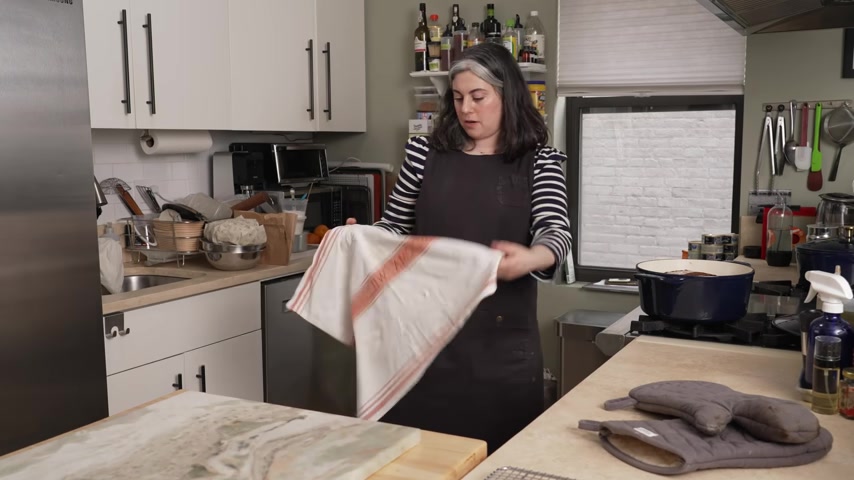
I checked on it .
I like to let it go until it's very , very dark brown , not burned because that creates an unpleasant bitterness .
But I like a little bit of , you know , really well developed kind of bitter flavors and complexity in the crust .
So I'm gonna pull the whole Dutch oven out .
Oh , big blast of heat to the face .
OK .
Oven off .
We do not need a 500 degree oven on in here .
Remember when you take your Dutch oven out that it's hot .
So be very , very careful .
I like to sometimes put a towel around the handles just to remind myself it's so easy to grab it and forget .
So , you know , you can do something like like this just to remind you gonna use tongs because what you don't want to do is get your hand in there and then accidentally tap it against the side .
So I have the parching paper which makes it really easy , just lift it out .
I'm gonna set it off to the side .
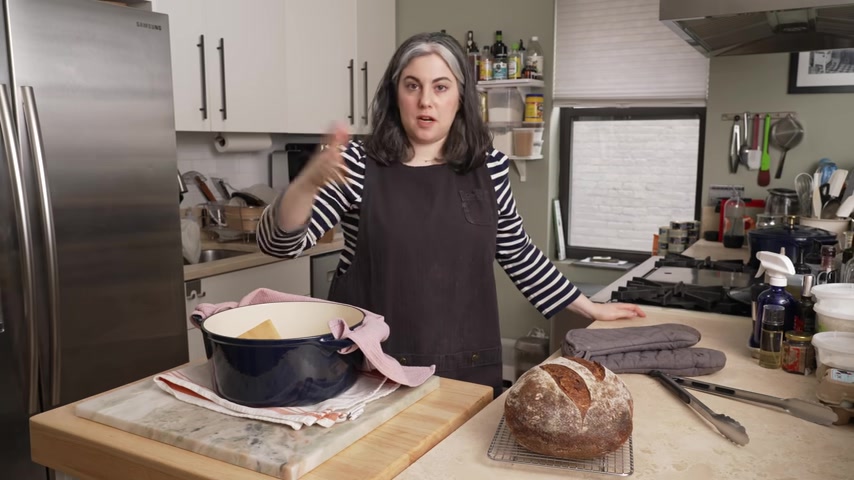
I think the shaping was relatively successful .
What I really like seeing are these little tiny blisters around the sides .
So you see these little tiny , like little air pockets that you can pop .
That is a sign that there was , you know , good fermentation .
You can see that right there .
I love seeing that all over .
And also if you give it a tap , like that should sound hollow , but , you know , baking at 500 degrees for 15 minutes covered and then half an hour plus uncovered , you know , that your bread will be done in the middle , right ?
So we just want to let this cool .
It's really important that you let bread cool completely before you slice it .
I know there's a desire to like tear in a warm bread and it sounds great and it tastes great , but it really does kind of destroy the texture of the crumb .
The problem is that all the steam escapes .
And so , rather than being reabsorbed into the crumb , it just kind of goes into the air .
The bread almost then dries out .
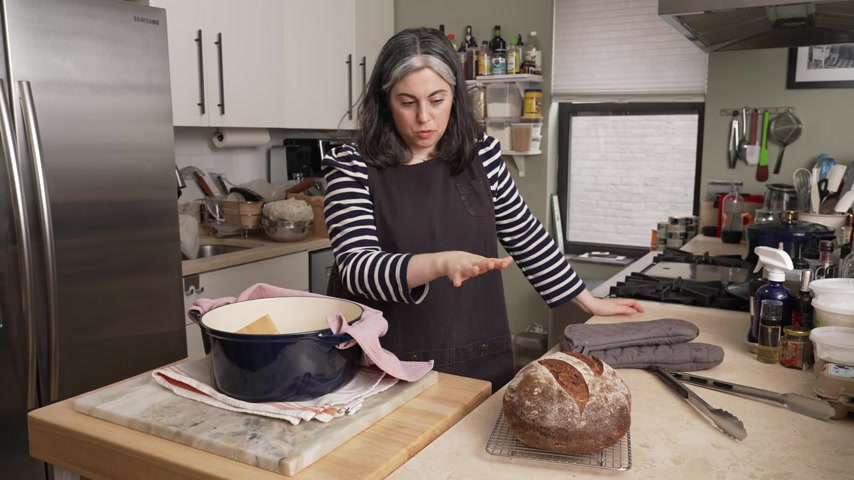
You get almost a Gummi when you slice it because it sticks to the blade , it's just not ideal .
So let it cool completely .
So several hours later the bread is cooled .
What you wanna do is go ahead and feel the bottom of the loaf and it should be completely cool to the touch , like no heat .
I mean , a tiny bit of warmth is ok .
But really you wanna let it thoroughly , thoroughly cool , that's gonna give you the best interior texture .
So now it's time to slice it .
Use a bread knife that's important because of all the whole wheat in here .
I expect to not have like a super open crumb .
It might be a little tighter .
But I still want to see , I can tell like I can tell there's a lot of air in here .
So I'm very excited to look .
Just want to see .
Wow , I'm really proud of this .
It looks really good .
It's even a little more open than I thought it would be .
So you see , there's like all sorts of different size holes from sort of bigger to small .
I love the flavor of it .
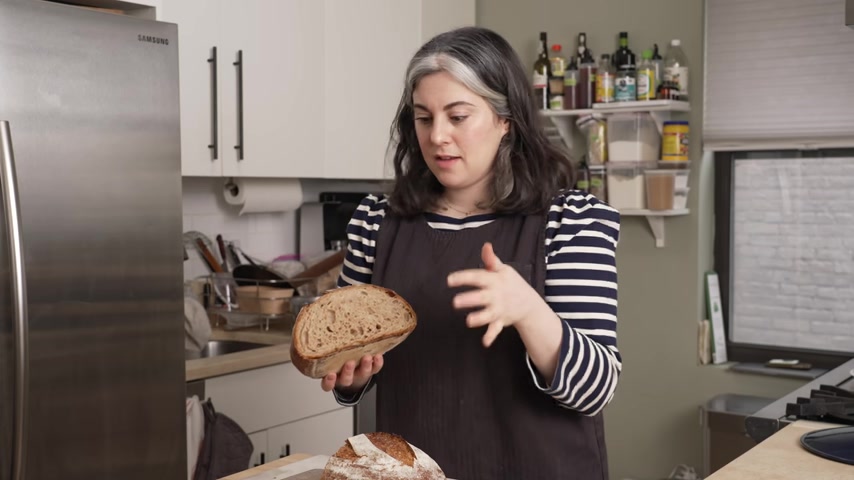
And I also like when I don't have like tons of really big open holes because when you're making toast and like all the butter and jam falls onto the plate .
So this to me is ideal for toast .
You can do sandwich bread makes like the most incredible grilled cheese so good .
But my favorite way to eat bread is just with a little butter on it and a little salt .
So I'm gonna do that .
I'm gonna cut a slice so we can taste it .
So the point of a bread knife or any kind of serrated knife is that it helps you get through something that has a soft interior and a hard crusty exterior .
Because if you were to try to go through this with a regular knife , you end up compressing it .
And there's like nothing that I hate more than like someone poorly slicing bread and just compressing the whole thing .
Actually , a really a well baked loaf of bread will spring back , but it's just like nails on a chalkboard .
So use a good serrated knife .
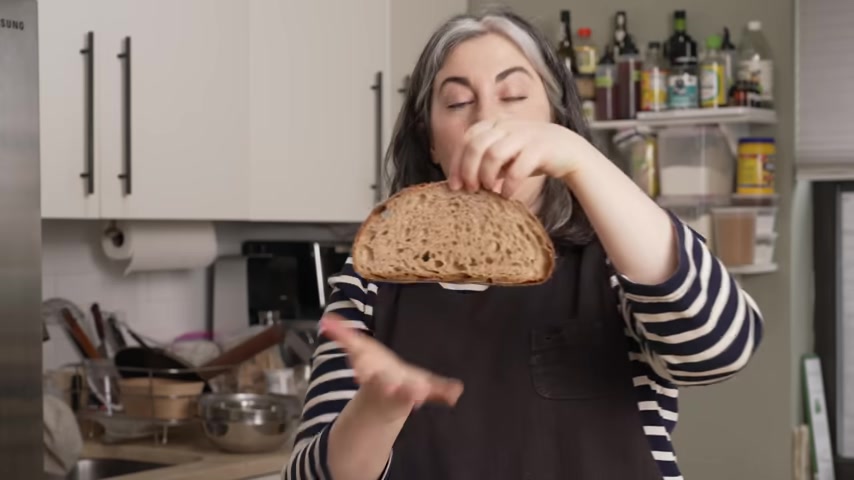
The bottom is well baked like it's or , or well done , but it's not burned .
And that's , I think a testament to the Dutch oven and the kind of evenness of the heat .
Let's look at the profile .
This is called the profile .
It looks excellent .
It's like nice even shape .
So , you know , I'm , I'm pretty adamant about not cutting into the loaf while it's warm .
If you want warm bread , you can just rearm it like , and then you get the best of both worlds .
So this is only the tiniest bit warm .
So if you want a little melted butter on it , just like , stick it in the toaster or something .
Now , I think fresh bread really doesn't need much of a toast if at all a flaky salt .
Just really like bread a lot .
That's my favorite food .
Bread and butter is like top five favorite food .
Especially good bread and good butter .
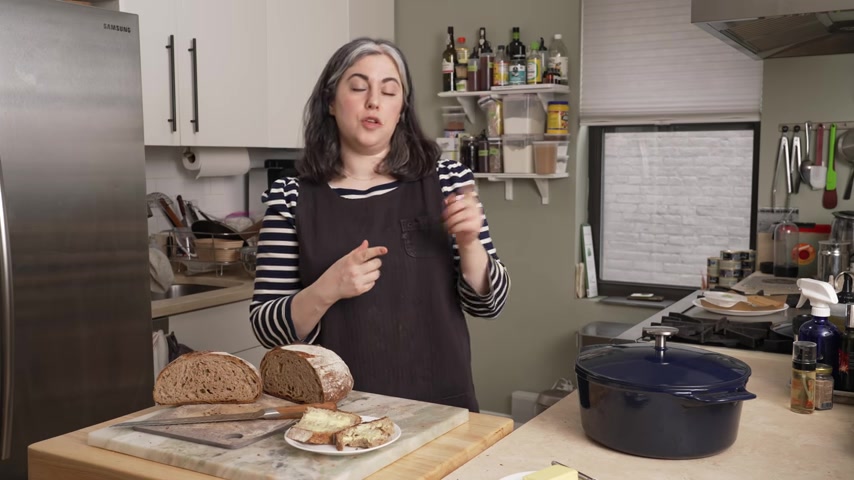
Hm .
It's pretty sour .
I like a sour sour dough .
Not everyone prefers that .
And in fact , I think bread makers often will kind of extol the virtues of like a less sour loaf where you're getting a little bit more of the wheat flavors in there .
Um , which I think has its bonuses for sure .
But I just love tangy bread .
So this is , it's so good .
It's light tangy .
I don't think it's that hard to find sour dough starter these days .
Ask a friend , ask a local bakery and once you get your hands on it , check out our episode where I make sourdough pancakes with discard so you can learn more about how to feed it and maintain it .
Oh , that comes , that comes later .
Stay tuned .
We're gonna have an episode coming up where I talk a little more about starter , how to feed it , how to maintain it .
And we're gonna show you what to do with the disc card , which is a normal part of the process of maintaining one .
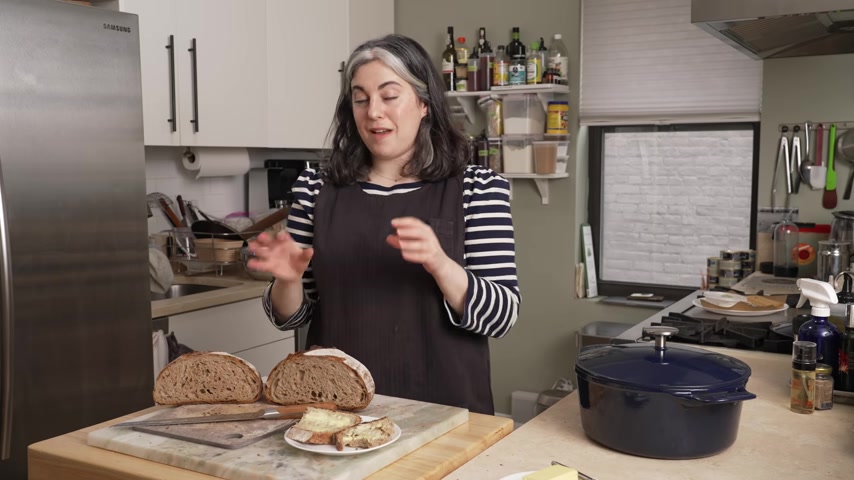
It is like having a very low key pet feed it once a week , keep it around and you can always have sourdough bread a day or two away .
It is one of my favorite things to do in the kitchen .
Get yourself a Dutch oven .
It is such a versatile piece of cookware .
You can use it for baking bread , for frying and for doing everything in between stews , soups , all of that braising .
Um I want to thank made in the makers of this beautiful Dutch oven for sponsoring this episode .
And I'm happy to introduce this beautiful new piece of cookware that you can get .
Check out the link below .
Use the code Clare 15 for 15% off your entire order , including their new Dutch oven .
And I just feel like super restored from this episode .
I love making bread .
It is a practice .
It's like my version of doing yoga .
I feel amazing .
I'm gonna eat the rest of this loaf .
So thank you for tuning in .
I'm so happy we're back with dessert person .
I can't think of a better way to return than by making bread .
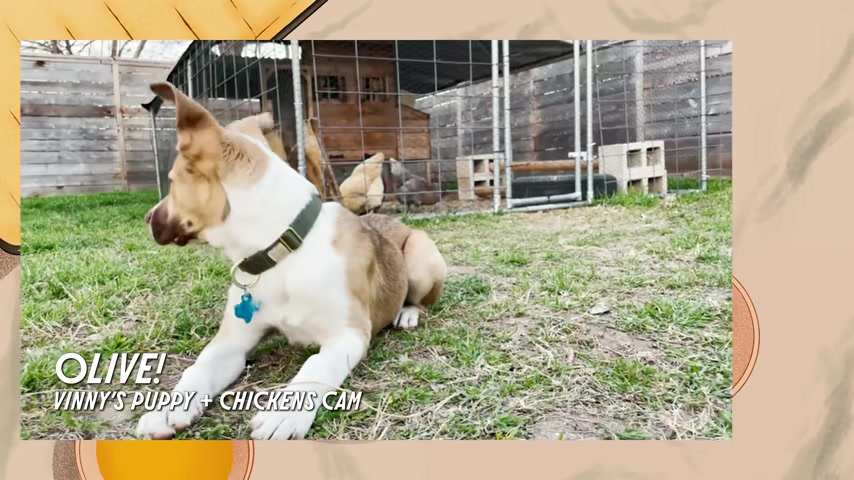
Thank you for watching and like and subscribe .
All right .
That's great .
That's a wrap .
Are you looking for a way to reach a wider audience and get more views on your videos?
Our innovative video to text transcribing service can help you do just that.
We provide accurate transcriptions of your videos along with visual content that will help you attract new viewers and keep them engaged. Plus, our data analytics and ad campaign tools can help you monetize your content and maximize your revenue.
Let's partner up and take your video content to the next level!
Contact us today to learn more.